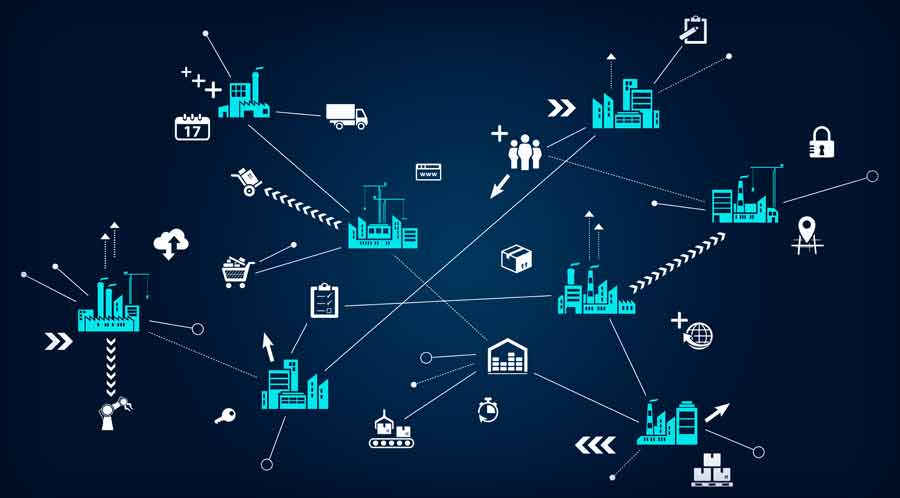Navigating the complexities of supply chain issues in recent years has been an extraordinary challenge for companies globally. From widespread disruptions to unexpected bottlenecks, businesses have faced a multitude of hurdles in maintaining smooth operations over the past three years. These challenges have not been confined to national borders but have echoed throughout the interconnected global supply network, emphasizing the intricate nature of modern supply chains. Shipping and logistics, in particular, have been a significant pain point, as companies battled for capacity and grappled with escalating costs.
In a concerted response, the US government has rolled out a series of initiatives designed to bolster the stability of the nation's supply chains. Although not solely focused on just shipping and logistics, these measures have the potential to influence various facets of the industry significantly. This analysis details the newly established White House Council on Supply Chain Resilience and offers some key insights into what businesses need to know. We explore actionable steps companies can take to leverage these programs and provide an in-depth look at how these changes are likely to impact American companies and the shipping and logistics industry, opening doors for innovation and strategic adaptation.
The White House Council on Supply Chain Resilience
The recently established White House Council on Supply Chain Resilience marks a significant shift in acknowledging the vital role that supply chains play in the economic and national security landscape of the United States. The Council is focusing on strategic ways to foster supply chain stability and resilience domestically and internationally. American businesses should take note of this development, as it has the potential to impact various sectors, from pharmaceuticals to clean energy to shipping and logistics. Understanding the main initiatives, and some potential implications and actively engaging with the rollout of these programs can help businesses navigate and adapt to the evolving supply chain landscape effectively.
Here are some of the initial and proposed initiatives:
- Collaborative Government Efforts in Supply Chain Management: Multiple government departments are collaborating to enhance supply chain monitoring and strategy through innovative tools and analysis. Crucial projects spearheaded by the government encompass the Supply Chain Center managed by the Department of Commerce and the Department of Transportation's program focused on sharing data.
- Major Investments in Essential Supply Chains: Significant funding is being allocated to vital supply chains. The Department of Energy and USDA are investing in clean energy and domestic food supply chains, focusing on critical materials, grid-scale batteries, electric vehicles, and reducing food costs.
- Risk Management and Resilience Building: The Department of Homeland Security is setting up a Supply Chain Resilience Center to mitigate risks, particularly in U.S. ports. This includes exercises to test cross-border supply chain resilience and monitoring climate and energy-related supply chain impacts.
- Engagement of Various Stakeholders: Both public and private entities are integral to improving supply chain resilience. The Council aims to use events like summits and hackathons to encourage expert input and innovative solutions, addressing global labor rights and conducting industry-wide supply chain research.
- Strengthening International Supply Chain Networks: Global partnerships aim to effectively identify and address supply chain disruptions before they become a global issue. These efforts cover critical areas like semiconductors, clean energy, and medical supplies, and involve collaboration with countries like the EU, Japan, Canada, and Australia.
The U.S. government's collaborative efforts in enhancing supply chain monitoring and strategic investments in critical sectors, like clean energy and food supply, are pivotal developments. These initiatives, involving substantial funding and interdepartmental cooperation, aim to bolster supply chain resilience and efficiency significantly over time. As we transition to discussing the potential impacts on the U.S. shipping and logistics industry, it's crucial to consider how these governmental strategies could revolutionize logistics operations, improve supply chain fluidity, and mitigate risks in domestic and international trade.
Potential Impacts on American Companies
From an investigative standpoint, the formation of this new council, expanded authority, and strategic investments warrant continued review and examination of their broader implications, if only to help inform the public how best to utilize and adapt to changes. Beyond the immediate enhancements in supply chain coordination and resilience, these developments could indirectly influence market dynamics, potentially leading to shifts in trade routes and logistics practices. As we delve into how companies within the shipping and logistics sector can proactively adapt, it's essential to consider the potential for increased regulatory oversight, shifts in demand due to the focus on clean energy and essential medicines, and the need for technological upgrades to meet these evolving standards and requirements. We put together a few general potential impacts that merit consideration.
Potential Positive Impacts:
- Enhanced Supply Chain Resilience: The Council's focus on bolstering supply chain resilience could benefit American companies by reducing the risk of disruptions. Enhancing the resilience of supply chains should lead to increased dependability from manufacturing to delivery and reduced costs for both companies and consumers alike.
- Lower Inflation: As supply chain pressures ease, there is the potential for a positive impact on inflation. Lower inflation rates can provide relief to businesses and consumers, potentially boosting economic stability.
- Domestic Manufacturing Opportunities: The expansion of the Defense Production Act into essential medicines manufacturing presents opportunities for American companies in the pharmaceutical sector and protects access to these key medicines for all Americans. Domestic manufacturing can reduce dependence on foreign suppliers and enhance supply chain control.
- Access to Data and Insights: Cross-governmental partnerships aimed at supply chain monitoring and data analytics can provide businesses with valuable insights into supply chain risks. Better data should mean better decision-making across nearly all industries, especially as there are more tools than ever before to help with complex data analysis and actionable insights.
- Investments in Clean Energy Sectors: Investments in industrial and clean energy sectors can create opportunities for American companies involved in manufacturing critical minerals, grid-scale batteries, and electric vehicles. This aligns with the broader trend toward clean energy and sustainable practices.
Potential Negative Impacts:
- Regulatory Complexity: The introduction of new regulations and initiatives can potentially add complexity to supply chain management. Companies may need to invest resources in compliance efforts and adaptation to changing regulations.
- Transition Challenges: Changes in supply chain dynamics, such as shifts in manufacturing locations or carrier preferences, can present transitional challenges for businesses. Adaptation may require time and resources.
- Pharmaceutical Industry Disruption: While the expansion of domestic pharmaceutical manufacturing is an opportunity, it could also disrupt established supply chain relationships and require significant investment in new facilities and capabilities.
- Supply Chain Data Sharing Risks: While data sharing can provide valuable insights, it also raises concerns about data security and privacy. Companies must navigate potential risks associated with sharing sensitive supply chain information.
- Economic Uncertainty: Any significant changes to supply chain dynamics can introduce a degree of economic uncertainty. Companies may need to carefully assess and adapt to evolving market conditions.
While there are many potential benefits in terms of supply chain resilience, cost reduction, and domestic manufacturing opportunities, there are also challenges related to regulatory complexity, transition, and data-sharing risks. American companies should remain vigilant, stay informed, and adapt their strategies to effectively navigate these evolving developments in the supply chain landscape.
Diving Deeper into US Shipping and Logistics
Alongside the establishment of the cabinet-level council, the White House has unveiled several additional initiatives that carry significant implications for the shipping and logistics landscape in the United States. Supply Chain Dive provided some key insights into the impact on shipping and logistics in a recent review of the US Supply Chain Council:
- Multimodal Policy Office for Freight Strategy: The Department of Transportation is set to launch a dedicated office for multimodal policy. This office will play a pivotal role in coordinating both national and state-level strategies pertaining to freight transportation. This initiative is in line with the requirements outlined in the Bipartisan Infrastructure Law, emphasizing the importance of a comprehensive approach to freight management.
- Broadening Powers in Critical Medicine Production: The scope of the Department of Health and Human Services' powers, under the Defense Production Act, is set to increase, aiming to boost the production of vital medicines and key ingredients within the United States. Such a development could significantly alter the dynamics of the pharmaceutical supply chain, affecting various aspects of logistics and distribution approaches.
- Investments in Clean Energy Sectors: The Department of Energy has recently completed a selection of grants totaling $275 million. These grants are strategically designed to strengthen the clean energy sectors, with a specific focus on manufacturing critical minerals, grid-scale batteries, and electric vehicles. Such investments hold the promise of transforming the transportation sector and affecting logistics considerations, particularly with the rise of electric vehicles and the demand for clean energy resources.
These initiatives, ranging from multimodal freight strategies to bolstering clean energy and pharmaceutical manufacturing, signify a comprehensive shift in the U.S. shipping and logistics paradigm. As we move forward, it's crucial for providers and shippers to understand the actionable steps they can take in response to these government-led changes, ensuring they are well-positioned to adapt and thrive in this evolving landscape.
Navigating the New Era in U.S. Shipping and Logistics: Key Steps for Providers and Shippers
Companies providing shipping and logistics services and those that are heavily reliant on those providers will need to stay informed about new regulations and government strategies, anticipating shifts in supply chain dynamics. This requires a proactive approach, with an emphasis on flexibility and innovation to adapt to these changes. Firms might need to invest in technology upgrades, re-evaluate their strategic partnerships, and even reconsider their service offerings to align with these new priorities. Understanding these shifts and preparing for them will be key to maintaining competitiveness and efficiency in this new era of U.S. shipping and logistics.
Embracing Technological Advancements for Enhanced Efficiency
In the rapidly evolving landscape shaped by government reforms and investments, it's imperative for companies to embrace technological innovation. The integration of advanced digital tools like AI and the Internet of Things (IoT), predictive analytics, and automation is revolutionizing the way businesses operate. For instance, in warehouse management, the implementation of AI-driven systems can lead to dramatic improvements in efficiency and substantial cost reductions. Consider a scenario where AI is used for inventory management: by predicting stock levels accurately, it minimizes overstocking and understocking, thereby optimizing inventory costs and space utilization.
Additionally, the introduction of automation and robotics in warehouse environments has the potential to provide significant efficiency improvements and minimize human errors. This not only streamlines processes but also leads to safer working environments. The use of IoT devices for real-time tracking ensures a seamless flow of information, allowing for proactive management of the supply chain. In addition, integrating these technologies with robust cyber-security measures is essential to safeguard operations and data integrity. By investing in these technologies, companies can not only enhance their operational efficiency but also gain a competitive edge in the dynamic world of shipping and logistics.
Adapting to Regulatory Changes and Embracing Sustainability
Adapting to the ever-evolving regulatory landscape is crucial for shipping and logistics providers. Staying informed about legislative changes, consulting with legal experts, and participating in industry forums are key steps towards ensuring compliance and gaining a competitive edge.
Monitoring the implementation of policies like the Defense Production Act is critical, especially for providers serving industries like pharmaceuticals. This can help in adapting to changes in supply chain dynamics. Monitor how the Defense Production Act is leveraged to bolster the domestic production of vital medicines. While the primary emphasis currently lies within the pharmaceutical sector, this initiative may establish a blueprint for comparable measures in other pivotal industries. Shipping and logistics providers serving the pharmaceutical industry should closely monitor these developments to adapt to potential changes in supply chain dynamics.
Simultaneously, a shift towards sustainability is reshaping the industry. This transition involves adopting eco-friendly practices like using electric vehicles, optimizing routes for fuel efficiency, and sustainable packaging solutions. These steps not only reduce environmental impact but also align with customer values and enhance brand reputation.
Preparing for Future Challenges Through Workforce Development
As the landscape evolves, the importance of investing in employee training cannot be overstated. Such training programs need to concentrate on emerging technologies, adherence to new regulations, and implementation of sustainable practices. Ensuring that employees are well-versed in these areas is crucial for meeting the rapidly changing demands of the industry. A workforce that is proficient and up-to-date is not just more productive but also more adept at navigating the novel challenges and innovations that characterize the shipping and logistics sector.
Engaging in Cross-Governmental Partnerships
Strong relationships with industry players, government agencies, and international partners are indispensable. These partnerships offer access to new markets and collaborative solutions, addressing industry-wide challenges. These engagements can also enhance decision-making regarding transportation and strategic inventory placement. Collaborations with the Commerce and Transportation Departments can certainly yield valuable tools for assessing and mitigating supply chain risks. By participating in these data-sharing efforts and finding ways to leverage these advanced insights, shipping and logistics providers and shippers can make more informed decisions regarding operations, strategy, routes, transportation modes, and inventory management.
Find Comprehensive Supply Chain Management Solutions
Evaluating comprehensive supply chain management solutions with a leading third-party logistics provider (3PL) can offer insights into every aspect of your operation. 3PLs can assist in identifying cost savings, refining strategies, evaluating carriers, addressing fulfillment needs, and exploring innovative solutions for supply chain optimization.
By staying attuned to government initiatives, engaging in data-sharing efforts, and seeking guidance from industry experts, like 3PLs, shipping and logistics providers and shippers can effectively navigate the evolving landscape. Proactive measures and strategic partnerships are key to maintaining a smooth flow of goods and minimizing disruptions in the supply chain.
Key Takeaways on the Evolving Supply Chain Landscape
The initiatives and focus of the new White House Supply Chain Council should offer some hope for a positive direction towards long term solutions to lessons learned from the pandemic. This move signifies the government's commitment to allocating valuable resources into critical sectors vital for an efficient supply chain. By understanding its structure, objectives, and actionable steps, companies can adeptly navigate these transformations, positioning themselves for success in an environment marked by fortified supply chains. The impact on companies is not to be underestimated, and it's crucial for businesses to stay informed and engaged to maximize the potential benefits offered by these transformative initiatives. As a leading provider of shipping, logistics, and supply chain services, Jillamy is prepared to help you navigate the challenges effectively. Contact us today at 800-592-7449 or on our contact us page.



